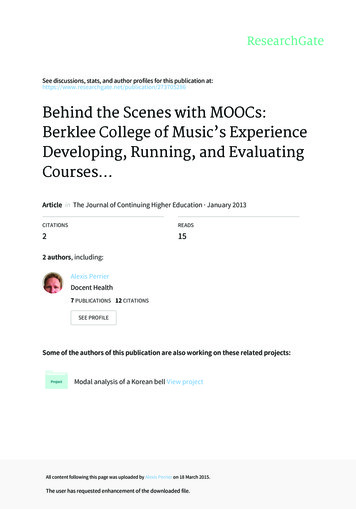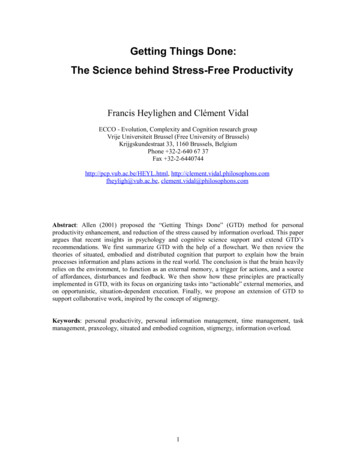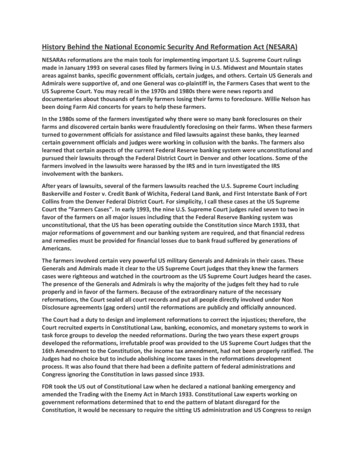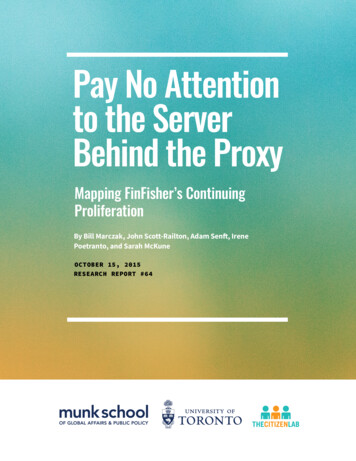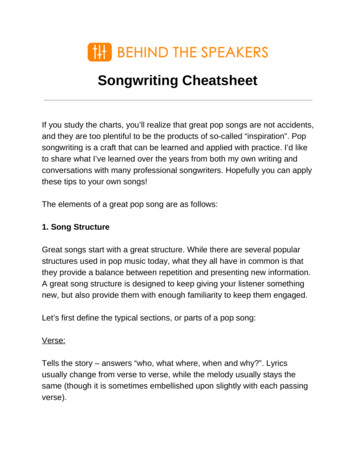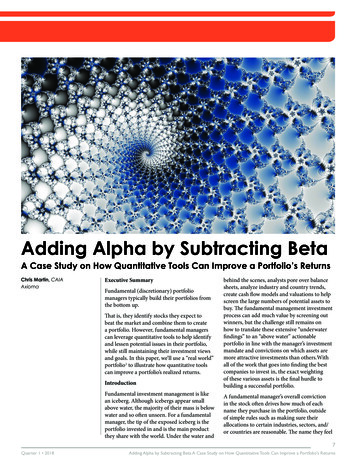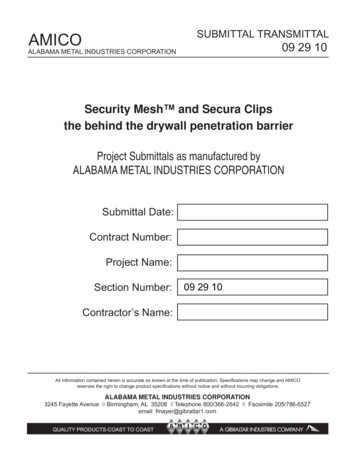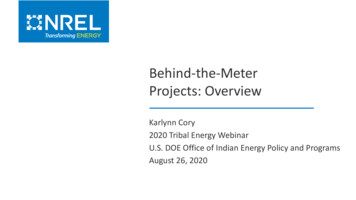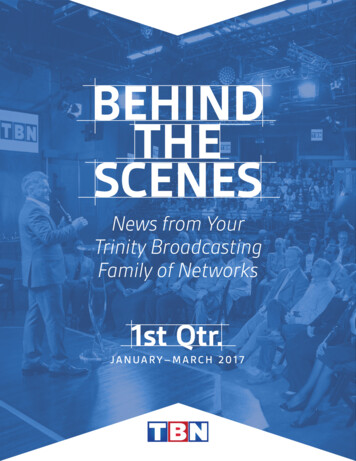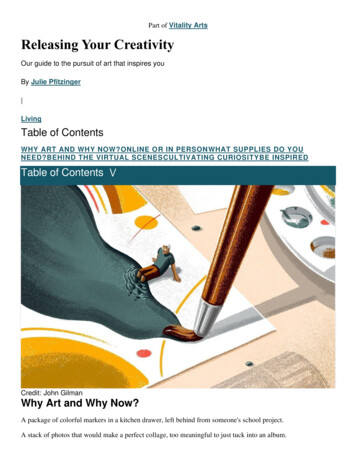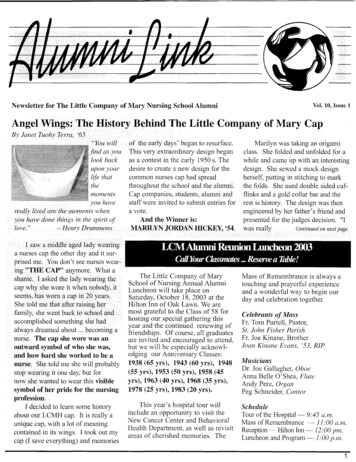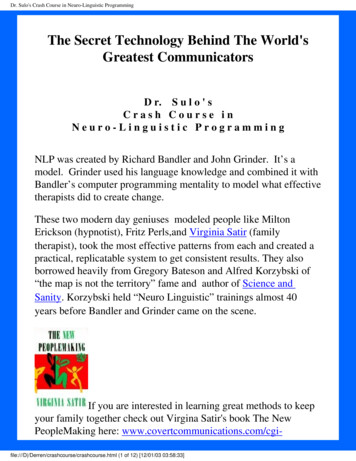
Transcription
Dr. Sulo's Crash Course in Neuro-Linguistic ProgrammingThe Secret Technology Behind The World'sGreatest CommunicatorsD r. S u l o ' sCrash Course inNeuro-Linguistic ProgrammingNLP was created by Richard Bandler and John Grinder. It’s amodel. Grinder used his language knowledge and combined it withBandler’s computer programming mentality to model what effectivetherapists did to create change.These two modern day geniuses modeled people like MiltonErickson (hypnotist), Fritz Perls,and Virginia Satir (familytherapist), took the most effective patterns from each and created apractical, replicatable system to get consistent results. They alsoborrowed heavily from Gregory Bateson and Alfred Korzybski of“the map is not the territory” fame and author of Science andSanity. Korzybski held “Neuro Linguistic” trainings almost 40years before Bandler and Grinder came on the scene.If you are interested in learning great methods to keepyour family together check out Virgina Satir's book The NewPeopleMaking here: www.covertcommunications.com/cgifile:///D /Derren/crashcourse/crashcourse.html (1 of 12) [12/01/03 03:58:33]
Dr. Sulo's Crash Course in Neuro-Linguistic Programmingbin/pl.cgi?vspeoplemakingInitially NLP was used mostly by therapists (since that’s where themodel originally formed from) and now it’s applications haveextended into almost every area of life (sales, business, negotiation,modeling, teaching, government, etc).One of the great things about NLP is that it contains models thatteach a person to effectively model other things.There are all sorts of outgrowths from NLP and it has becomesomewhat of an industry. 90% of what Tony Robbins does is NLPbased. He decided to rename it Neuro Associative Conditioning(NAC).Here’s the core of NLP (there are all kinds of spin offs from thebase model)First of all NLP is based entirely on certain presuppositionsPresuppositions could be considered base beliefs. Kind of like anoperating system on a computer. Every program you run goesthrough that operating system (i.e.-Windows). So, the more flexiblethe operating system the more options you have when running aprogram.Presuppositions are the internal, mental environmental structure webuild that directs our 7 -2 bits of conscious attention span. This isthe Greenhouse effect I talk about in my persuasion newsletter,except applied internally.These presuppositions form the environment from which all NLPtechniques take form.Bandler defines NLP as “an attitude, backed by a methodology,file:///D /Derren/crashcourse/crashcourse.html (2 of 12) [12/01/03 03:58:33]
Dr. Sulo's Crash Course in Neuro-Linguistic Programmingwhich leaves a trail of techniques”. Most people who are familiarwith NLP just know of the techniques.Bandler has also said that he created NLP so he could do whateverhe wanted. From what I’ve experienced, ALL of Bandler’strainings are created in such a way as to INSTALL THE NLPATTITUDE which basically is all about FLEXIBILITY. He jarsyour consciousness through stories and unconscious communicationto create a more flexible mental system. ATTITUDE (and your stateof mind) is everything in NLP. Controlling your state and attitudecomprise the majority of what NLP is all about.The point is that the basis of NLP is the presuppositions and theattitude you have when you use these presuppositions. Here aresome of them (list taken from The User's Manual For The Brain byBobby G. Bodenhamer and L. Michael Hall. I recommend thisbook highly if you are just starting out in NLP. The explanations ofeach of the presuppositions are mine.):If you really want to learn NLP (easily) from A to Z youMUST BUY THIS BOOK!your mental map. The Meta Model adds more details. The MetaModel gives usmore choices through details. When you want to add more detailsto someone’s mental map use the Meta Model.The way the Meta Model is explained in many books makes it verycomplicated when in fact it's not.If you truly want to get advanced you can learn all aboutfile:///D /Derren/crashcourse/crashcourse.html (3 of 12) [12/01/03 03:58:33]
Dr. Sulo's Crash Course in Neuro-Linguistic Programming"comparative and superlative deletions," "universal quantifiers,""modal operators" and more by getting the book I recommend: TheUser's Manual For The Brain.This is a Crash Course, so all we're interested in here is enablingyou to start using some of this material TODAY. So, I'm about toshow you a little trick that can sidestep 10 days of training in theMeta-Model so you can start using it right away.1. WHEN DO YOU USE THE META-MODEL?This question is important. Using the Meta-Model at the wrongtime in the wrong way can create enemies.Why?Well, let's say you said to me, "I always do well at school." and Isaid "Always?"You might say with dissapointment as you think and remember,"Well, there was a time that I failed this math exam."What did that do? ALWAYS is a generalization and the MetaModel makes us go to specifics. However, in this case I didn'treally help the other person out by making them get more specificdid I?So, when DO you use the Meta-Model? When someone's deletions,generalizations, and distortions are not helping them or you.For example, a customer says "No one buys used cars from Fordanymore." You COULD say, "Who specifically do you mean whenyou say no one?"This kind of questioning makes people re-consider their maps.file:///D /Derren/crashcourse/crashcourse.html (4 of 12) [12/01/03 03:58:33]
Dr. Sulo's Crash Course in Neuro-Linguistic Programming2. HOW DO YOU USE THE META-MODEL?I make it real simple. When someone says something that iscoming from a map that is restricted and does not allow them theperspective they need on a situation I simply ask questions andhere's some examples to try out: "I can't learn math" - What would happen if you did didn'tlearn math? (Gets the person to look at what they think ispossible more closely.)"That's not important"- According to whom? (Gets the personto search for the reference for this value judgement and fromthere they can evaluate whether it's useful or not- with a littlehelp from you.)"Nobody loves me" - Who specifically doesn't love you? (Getsthem to define a real reference point and then you can go fromthere. Many times people will take an isolated situation andgeneralize it across their whole life. So, if one specific persondislikes them- they think EVERYONE dislikes them.)"I'll be better off if I don't buy this car" - Better off accordingto what standard? (This gets them to look at theircomparisons)"He really screwed me over" - How did he screw you overspecifically? (This gets the person to truly define what theymean by the verb "screwed")Another effective way to use the Meta-Model is to ask thesequestions of yourself and then create a story thay illustrates thatthere are other options for the person involved.The following chart is reprinted with permission from The User'sfile:///D /Derren/crashcourse/crashcourse.html (5 of 12) [12/01/03 03:58:34]
Dr. Sulo's Crash Course in Neuro-Linguistic ProgrammingManual For The Brain by Dr. L. Michael Hall and BobBodenhamer.file:///D /Derren/crashcourse/crashcourse.html (6 of 12) [12/01/03 03:58:34]
Dr. Sulo's Crash Course in Neuro-Linguistic Programmingfile:///D /Derren/crashcourse/crashcourse.html (7 of 12) [12/01/03 03:58:34]
Dr. Sulo's Crash Course in Neuro-Linguistic ProgrammingTHE MILTON MODEL (VAGUENESS)The Milton Model is nearly the inverse of the Meta Model.99% of the verbal “patterns” you hear from gurus are based entirelyon the Milton Model. Its aim is the same- to increase choice andexpand mental maps to increase flexibility.The Milton Model was modeled after Milton Erickson, a brilliantconversational hypnotist. Hypnosis or trance involves a personhaving an inward focus.If I tell you to think of a time where you met a certain person whomyou really enjoyed being around and as you think of this person andas you read these words you allow a clear picture to form of thatperson, maybe hear their voice, smell their scent, you may begin tonotice all those certain feelings you have, good feelings andYOU’RE UNCONSCIOUS knows how to make you have thosegood feelings anywhere. NOW, as you read this, YOU’REUNCONSCIOUS can transfer those good feelings to LEARNING,really LEARNING this material. Because, FEELING GOOD,allows you to learn soooo much quicker. And I don’t know if youcan begin to apply all you are learning from reading this right awayor if you’ll just start using it when you’re finished reading. I doknow that tonight you’ll sleep and dream and as you sleep anddream YOU’RE UNCONCIOUS NOW can begin to INTEGRATEall you’ve learned here and manifest new behaviors, new attitudesand new beliefs that will INCREASE YOUR FLEXIBILITY ANDJOY. NOW, you can come back now.Unfortunately, hypnotic language patterns don't work all that wellfile:///D /Derren/crashcourse/crashcourse.html (8 of 12) [12/01/03 03:58:34]
Dr. Sulo's Crash Course in Neuro-Linguistic Programmingon paper. So, please, take the above paragraph with a grain of saltand a smile on your face.Vagueness allows you to internally find references for the words Iuse. When I say a “certain person”, you’re mind searches it’s databanks for a certain person. The Milton Model occupies theconscious mind with words while the unconscious mind does all thework. The Milton Model taps the unconscious’s ability to use allyour inherent resources and not be restricted to the conscious minds7 /- 2 bits of information. Read Patterns Of The HypnoticTechniques Of Milton H. Erickson, M.D.The use of hypnotic language, along with proper voice inflectionand something called embedded commands CAN be very powerfuland very persuasive.The underlying theme in all this is that your unconscious mind canhear things and interpret things differently than your consciousmind can. Your unconscious mind looks for patterns. Yourconscious mind listens to the words. In hypnosis and the metamodel you are almost doing a magic trick by keeping yourconscious mind occupied while you are speaking directly tosomeone's unconscious processes.THE FOUR FACILITATING MODELSANCHORINGTony Robbins calls it Neuro Associative Conditioning. Youlearned it in presupposition #17 (Humans have the ability toexperience one trial learning). Pavlov rang his bells and dogssalivated. How do you feel when I say IRS Audit? What about thatfile:///D /Derren/crashcourse/crashcourse.html (9 of 12) [12/01/03 03:58:34]
Dr. Sulo's Crash Course in Neuro-Linguistic Programmingsong that reminds you of that person you loved 10 years ago, whenyou hear it does it bring back all the feelings involved? We canassociate anything with anything. Remember a time right beforeyou purchased something that you really wanted. You know, whenyou walk into a store, or pick up the phone to dial into a catalog, orlog onto that website and you just can’t wait to get it. Maybe youheard about it from a friend, read about it somewhere and it piquedyour interest and curiosity to the point where NOW you just have tohave it. See what you saw right before you bought it, Hear thewords you told yourself (maybe “I gotta get this”), feel all thosefeelings. NOW, as you enjoy those feelings say these words in yourmind “DOKTOR SULO”. Again, “DOKTOR SULO”. Very good.REFRAMINGSee Presupposition #12. Reframing is one of the most extensivelyused techniques in NLP by Richard Bandler. Most comedy appliesreframes. Your mind is heading down a road it’s been a milliontimes and you expect it to continue that way. Then WHAM! Areframe redirects you.RAPPORT BUILDINGAs I said earlier, if you have enough rapport you can do almostanything. Most verbal patterns fail to work because A. the persondidn’t create a context where the verbal pattern is appropriate andB. there wasn’t enough rapport. Rapport is gained by making aperson feel you are like them. You can do this in a variety of ways.You can match their voice tone, tempo and breathing. You canmirror or match their body posture. You can match their beliefs.You can match their phrasing and their key words. The key torapport is: you want to gain rapport rapidly- then you want to leadthat person into your frame (context). People like what’s the sameor similar and learn from what’s different.file:///D /Derren/crashcourse/crashcourse.html (10 of 12) [12/01/03 03:58:34]
Dr. Sulo's Crash Course in Neuro-Linguistic ProgrammingPACING AND LEADINGAs you read this last portion of the CRASH COURSE IN NLP,while you are sitting at your computer or reading this on the printedpage you may begin to think to yourself “The Doktor has reallymade NLP simple to understand in his Crash Course”. And as yousay that, and as you continue reading this and your mind processesthe words, you can begin to feel good about all that you learnedhere. And as you feel good about that, you may feel a compellingurge to EMAIL DOKTOR SULO and ask him when part II iscoming out, or not. It’s your choice.To close, I do want to say that true learning never takes place if youjust read something. True learning involves at least the three majorrep systems (SEE HEAR FEEL). So, go ahead and allow all this tosink in and integrate as you sleep and dream tonight and tomorrowwhen you wake up you may begin to notice certain changes in theway you go about things. Some people even tell me their whole lifechanges with this material. Even so, it’s always good to have reallife examples of people so you can SEE, HEAR AND FEEL NLP inaction. So, go ahead and go to a seminar hosted by an excellenttrainer and incorporate this material into your life.I also recommend you subscribe to the FREE weekly AcceleratedPersuasion Newsletter by ersuasively,Christopher Tomasulo 2000,2001,2002 BY CHRISTOPHER TOMASULO. ALL RIGHTS RESERVED. DOKTOR SULO'S CRASHfile:///D /Derren/crashcourse/crashcourse.html (11 of 12) [12/01/03 03:58:34]
Dr. Sulo's Crash Course in Neuro-Linguistic ProgrammingCOURSE IN NLP IS A
comprise the majority of what NLP is all about. The point is that the basis of NLP is the presuppositions and the attitude you have when you use these presuppositions. Here are some of them (list taken from The User's Manual For The Brain by Bobby G. Bodenhamer and L. Michael Hall. I recommend this book highly if you are just starting out in .

